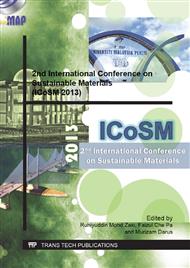p.266
p.272
p.276
p.281
p.286
p.290
p.294
p.299
p.304
Effects of Calcium Carbonate on Melt Flow and Mechanical Properties of Rice Husk/HDPE and Kenaf/HDPE Hybrid Composites
Abstract:
In this research, calcium carbonate (CaCO3) was compounded with rice husk/high density polyethylene (HDPE) and kenaf/HDPE composite at different filler loadings to produce hybrid composites. Melt flow index (MFI) and mechanical properties of hybrid composite was investigated. From the test results, the addition of CaCO3 filler had decreased melt flow index (MFI) on both composites. In terms of mechanical properties, tensile strength, elongation at break and impact strength decreased, whereas Youngs Modulus increased with the increase of CaCO3 in both kenaf/HDPE and rice husk/HDPE composites. Impact strength of unfilled rice husk/HDPE composite was lower than unfilled kenaf/HDPE composite, however impact strength of CaCO3/rice husk/HDPE hybrid composite were found to have slightly higher than CaCO3/kenaf/HDPE hybrid composite with addition of 10% and 20% of CaCO3.
Info:
Periodical:
Pages:
286-289
Citation:
Online since:
September 2013
Authors:
Price:
Сopyright:
© 2013 Trans Tech Publications Ltd. All Rights Reserved
Share:
Citation:


